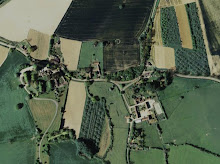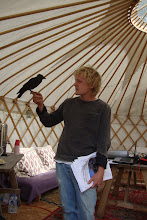
Another Christmas present this year was this, No. 102 in the Collins New Naturalist Series: 'Garden Natural History' by Stephen Buczacki.

I am only half way through the book so will reserve an overall judgement of its quality, but there are parts where the Buczacki's awareness of habitat value seems a little lacking. The coverage of orchards and fruit trees is fairly limited. He mentions mistletoe (but not the associated fauna) and different suites of bark dwelling organisms but fails to highlight the importance of dead wood and rot holes (e.g. Noble Chafer), blossom, and windfall for overwintering birds. On page 100 there is also this passage that I have to highlight to you as perhaps a little benighted (N.B. highlights added by me):
"Both coppicing and pollarding are among the most functional and degrading uses to which a tree can be put and the resulting plants are unsightly; witness the pollarded limes of many of our urban streets which should teach gardeners a lesson in species selection. If you cannot accommodate a full-grown tree of any species in your available space, then choose a small species rather than hideously abbreviate a large one."
Woah now!

© Copyright
1) Do you think this ancient alder pollard has been hideously abbreviated?
2) How can anyone take offence to the pollarded trees that grace our cities? As a counter-example, consider the London plane, a tree allowed to reach huge sizes in our capital and that can be pollarded to suit. Does Stefan think a more dwarfing species would have a high enough crown to avoid blocking passing buses and lorries? Is he suggesting we do without roadside trees altogether if no natural tree form is both very tall, pollution resistant and has a compact crown? This height is necessary to provide natural balance to our lofty city architecture.
2) How can a man who has spent his life advising people in the manipulation, control and propagation of plants for gardens suddenly be offended by an ancient form of tree management? Pollarding and coppicing have been practiced in Europe for over a thousand years. Pollarding is also only a special type of pruning after all - can he be suggesting that pruning is also 'degrading'?
3) Take a look at the UKBAP for 'Lowland wood-pasture and parkland'- surely this type of tree management has beneficial consequences that far outstrip any romantic notion of tree exploitation?



It's an interesting one isn't it. One thing I've become increasingly aware of with regard to 'experts' in the media, is just how lacking in detail and accuracy their opinions often are. I can listen with great admiration to the Radio 4 Gardeners Question Time pannelists dishing out expertise to the masses, that is until they touch on a subject I have a modicum of knowledge of. The inaccuracies, and sometimes downright wrong advice offered leads me to (doubtless unfairly) question the validity of all their advice.
ReplyDeleteIt's the same across all forms of media, TV and newspapers seem to be the worst. The accuracy of books purporting to offer 'expertise' on a given subject seems to be in inverse proportion to the size of the target audience. The more accesible the delivery of complex issues, the more dumbed-down and error-ridden the information. I've given up with gardening books since they so often contradict each other on fundemental practices and methodology. It's all opinion, heresay and far too much folklore-as-fact.
Having said all that, this book seems to be concerned primarily with gardens. Although I can see the appeal of coppicing, is pollarding really an approriate form of pruning in a garden setting?
Your right, I can't imagine many scenarios where pollarding would be suitable in a garden. However, the quote is within the subsection 'woodland' in the chapter 'Gardens in the context of the British ecological landscape'.
ReplyDeletePersonally, I think that were you to be fortunate enough to have an old pollard incorporated into your garden you should be appreciate it as a valuable landscape feature and not consider it some aberration from a by-gone era. Not to mention the great ecological value of such things. I just thought it was a bit narrow minded, especially from someone who studied forest science at Oxford!